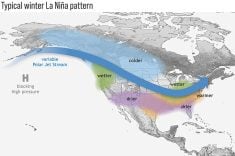Autumn is the best time to do something about preventing open cows, says North Dakota State extension beef specialist Kris Ringwall.
“I have come to realize that if a producer is really going to do much about open cows, now is the time,” he said.
“Why? Well, stop and think about it. When is the only time a cow is not doing much? In my book, that’s just after she weans a calf.”
For northern plains producers whose cows calve from February through April, that would coincide with the late fall months. At the NDSU Dickinson Research Extension Center, it is mid-October to mid-November.
Read Also

Canadian Food Inspection Agency extends chronic wasting disease control program consultation deadline
Date extended for consultation period of changes to CWD program
In many cow herds, calves get all the attention at this time, while cows are turned out to fend for themselves until the snow falls, generally around 30 days later.
This time, however, is the opportunity to improve the cow’s condition.
It is not nursing a calf. It should be in the middle third of gestation, and it is not fighting cold winter weather. Cows need energy to gain back some of the condition lost to good production. They also need enough protein to effectively use roughage.
Weigh your cows at weaning and at the start of winter feeding. Does your benchmark value show weight gain or loss?
If your cows lost weight, you missed the one period of a cow’s life when significant progress can be made to improve their condition.
The average pregnancy rate for herds using the Cow Herd Appraisal Performance System (CHAPS) is 92.9 percent for the last five years. The top third was at 94.4 percent, the middle third was 93.7 percent and the bottom third was 91.3 percent when herds were sorted based on age-adjusted weight weaned per exposed female.
Herds that weaned the most weight per cow exposed had a 94.4 percent pregnancy rate. That means top herds are ending the breeding season and starting the last trimester of pregnancy with three extra calves for every 100 cows.
Input costs have to be monitored so they don’t exceed the value of the extra calves. A producer may overfeed and spend too much money, but that is not the norm.
CHAPS data show that top producers will have pregnancy rates in the fall from 91.6 percent to 97.2 percent. There will even be years when 100 percent of the cows are pregnant. This is quite different for the bottom producers who will range from 87.2 percent to 95.4 percent.
In today’s cattle business, a 90 percent pregnancy rate should be the lower limit and 95 percent should be the goal.
Don’t blame poor spring weather for your calving rate. Work this fall to get back what those cows put into their calves this season. Bull failures and herd health can also be problems, but first check the condition of the cows.
If the pregnancy rate is lower than your goal, adjust your management.
Pregnancy check your cows now, sort the thin cows off and feed them. Don’t assume the medium to heavy cows can maintain themselves on dry fall pastures and crop land.
Institute a program of forage checks and provide a targeted nutritional program for all your cows. They will reward you next fall.














